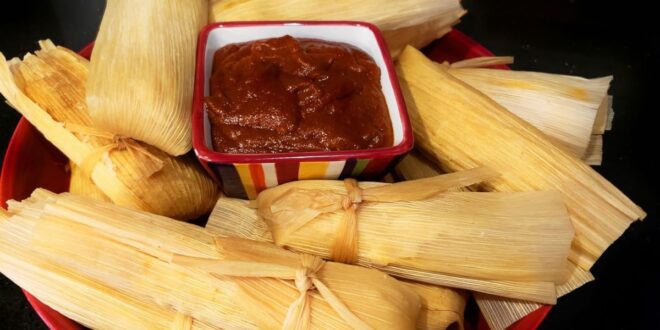Tamales are a popular comfort food with many since it is warm, steamy, and soft. However, when making Tamales, many seem to struggle to get it right, often mistiming the steaming to the point the whole dish becomes either overcooked or slimy. How long do you steam tamales?
In general, you should steam your tamales for 35 minutes. When steaming, try to avoid packing the tamales too tight, or the steam cannot get through the leaves. You also want to cover the top, exposed part of the tamales with extra corn husks and a clean cloth. Your Tamales are cooked with the leaf peels away from the Tamal easily.
This article discusses preparing tamales and how long you should steam them. We also explore subjects such as if you need to sit tamales or how long you should steam cold tamales. We also venture into the hot debate if you should steam tamales standing up or lying down.
What Are Tamales?
Tamales are a cornmeal-based food popular in north and south America. It is often wrapped in corn husks, together with some fillings. It is steamed and eaten on the go. Fillings can be either savory or sweet, and wide regional varieties exist.
Tamales is a dish originating from Pre-Columbian Mesoamerica. This means this may be a native Aztec and Maya dish before the arrival of the Spanish in central and south America. The most popular version of Tamales is Mexican, although most central and south American countries have developed their own Tamales.
Tamales are usually made by mixing a mixture of corn dough (masa) and fat with some filling. These are then wrapped in a corn husk and then steamed. At times, banana leaves are also used to wrap the filling.
During steaming, the corn dough becomes firmer, forming a cake-like consistency. The Tamale can then be unwrapped and eaten on the go.
Tamales may be called different names depending on where you are. You may hear terms such as Tamals, Tamalitos, or Pasteles being used to call Tamales. You may also hear Tamales being called Hallacas. In Andes countries such as Peru or Bolivia, you may hear the term Humitas.
There are two major parts to prepare when making tamales: corn dough and fillings.
Corn Dough (Masa)
Tamale Masa is prepared by mixing dried cornmeal with broth, usually the leftover from cooking the meat used in the filling. Some lard and seasonings are also added to the mix until it forms a soft dough.
The most common is the masa, which you can easily get from many department stores. It is essentially ground corn treated with lime to remove skin and hulls, turned into a dough, dried, and ground up again to form fine cornmeal.
Tamale Fillings
Tamale fillings can vary a lot. Most common tamale fillings are made with chicken and pork, and these meats are usually prepared by slow cooking. During the slow-cooking process, potatoes, corn, peppers, and carrots are added to the mix.
What Are The Types Of Tamales?
There are two major types of Tamales, savory and sweet. The most popular Tamales types include Chuchito, Chaya, Hallacas, Humitas, Nacatamal, Tolimense, Zacahuil, and more. These tamales may be made with chicken or pork and may either use corn husks or banana leaves.
There are many types of Tamales that you can sample. However, there are some that are very popular and are well-loved by foodies. These include:
Chaya
Chaya Tamales are usually made with pork, olives and pepitas. It also does not use regular corn husks but chaya leaves instead. Chaya Tamales are popular across Mexico and Belize.
Chuchito
Chuchito is a small tamal filled with meat and then cooked in vinegar and spice soup called the Recado. They are consumed with additional Chile sauce and a dried Guatemalan cheese called Zacapa.
Colorado
Popular in Guatemala, Colorado Tamales are made with chicken and usually have warming spices such as cinnamon and clove. It is commonly eaten during Christmas and New Year’s.
Güemes
This Tamales is said to come from Baja California. The dough contains olive oil and lard, which means they tend to be denser and have a better mouthfeel.
Hallacas
Popular in Venezuela, it is commonly made with a stewed filling containing raisins, spices, and meats. Commonly used meats include chicken, pork, and beef.
Humitas
Humita Tamales are not commonly steamed but boiled like dumplings or pasta. They also do not contain any fillings. People commonly dip the Tamal into condiments or sauces.
Nacatamal
Popular in Nicaragua, Nacatamal Tamales is a hearty one. When you tear into one, expect to see pork, chicken, rice, veggies, and potatoes. You may see olives, capers, tomatoes, and raisins as well. Meats are commonly seasoned with bitter orange.
To license
Originating from Colombia, Tolimense Tamales come with chickpeas, eggs, pork, and vegetables. Instead of corn husks, you may see Tolimense Tamales wrapped with a plantain leaf.
Zacahuil
Famous in Veracruz, Mexico, Zacahuil Tamales usually are made with turkey and chile. It is made to impress and feed a large crowd. It may be as long as sixteen feet.
How Long To Steam Tamales?
Tamales usually steam for 35 minutes to cook. Steam your Tamales standing up, and try not to pack them too tight to allow them to expand. When steaming, cover the top of the tamales with additional corn husks and a clean cloth. After steaming for 35 minutes, leave to sit for 30 minutes as well.
People often struggle to get their Tamales to steam up well, either over steaming or under steaming theirs. How long should we really steam Tamales?
If you are steaming your tamales in a steamer, steam is under a low boil for 35 minutes. When arranging your tamales for steaming, ensure that you do not pack them too tight, as you need to give the cornmeal space to expand. Pack them too tight; your tamales may not cook well and may have a very dense bite.
To save space during packing, pack your Tamales facing up. However, you can steam your Tamales lying down if that arrangement suits your requirement.
After arranging your tamales, cover the top with some additional corn husks to prevent water from dripping into the tamales. Also, add a piece of clean towel on top before closing your steamer.
After steaming for 35 minutes, remove the steamer from the heat, and allow it to sit for another 30 minutes. This should allow the heat inside to slowly cool down; some believe that doing so allows the corn and filling to gel and taste better. It is also safer since you are not going to deal with a sudden gush of steam when you open the steamer.
You may like this article: What Is The Best Way To Reheat Tamales?
How To Know When Your Tamales Are Done Steaming?
You should know your Tamales are done steaming when the Tamale Masa separates easily and cleanly from the cornhusks. Your Tamales should also have a nice texture and are not overly slimy or mushy when eaten.
One of the things that you may worry about steaming Tamales is if they are done steaming. You could follow the instructions to the dot by steaming for 35 minutes and leaving the steamer for 30 minutes.
However, you need a clearer sign that your Tamales are done steaming and are ready to be eaten and enjoyed.
If you want to confirm whether your Tamales are cooked or not, tear open a tamal, and try to separate the corn husks from the Tamal and fillings. The Tamal should separate itself from the corn husks easily and cleanly.
In fact, the separation should be so clean you can even see the lines of the corn husks on the Tamal itself.
Once you have done that, you are halfway to confirming that your Tamales are well-done. The next step would be to use a spoon and cut some out. They should separate well. As you chew into the Tamal, it should have a little bit of texture and not be slimy or mushy.
If your Tamales pass both tests, they are good to go. Stack them up, serve them to your guests, and watch them devour them.
Do Tamales Need To Sit After Steaming?
You should sit your tamales for about 30 minutes after steaming. You allow the flavors to gel together by giving it time to sit. The excess juice from the fillings is to be reabsorbed by the Tamal and the meat. If you do not sit your Tamales, they may be dry, tough, and too hot to eat.
One of the most common mistakes many people make when making Tamales is not sitting them. You can set your Tamales by removing the steamer from the heat source and allowing the Tamales to remain inside the steamer for 30 minutes.
There are many reasons why you should sit your Tamales. During steaming, a lot of heat was introduced to the Tamales, which means the pressure is high. These high pressures may have pushed out some of the juices from the fillings and the Tamal.
If you sit your tamales, you give time for the steam pressure to slow down, allowing the juices to be reabsorbed back into the fillings and Tamal. This prevents your Tamales from becoming too tough and dry.
By setting your tamales, you also allow the Tamales to cool down slightly. When it is too hot, it may be very difficult for you to handle it. It may also be difficult for people to eat the Tamales since they may be too hot, dry, and tough.
Many cooks also believe that sitting your Tamales allows more time for the flavors to gel and meld. Which means your Tamales may taste heavenly.
How Long Do You Steam Cold Tamales?
If your Tamales are cold, reheat them by steaming them inside a steamer for 15-20 minutes. If your Tamales are frozen, steam them for 20-30 minutes. Always keep your tamales in their husks, and do not pack them too tightly while steaming.
Tamales are one of those foods that travel very well. You can make a batch of beautiful Tamales, chill or freeze it, and then take it anywhere in an icebox. You can reheat it, and your tamales taste just as good.
The key to reheating Tamales is to always steam them and not rely on instant heating appliances such as microwave ovens.
Pack your chilled Tamales into your steamer, fill it with water, and steam it under medium heat. When packing, ensure not to pack them too tightly, to allow even distribution of hot moist air to warm up the Tamales.
If your Tamales are chilled, steam them for about 15-20 minutes. If they are frozen, steam them for an additional 10 minutes. This allows the steam to heat for more time to thaw the frozen Tamales. Ensure to keep the Tamales in their husks. There is no need to remove anything.
Finally, once you have steamed the Tamales, consider giving them some time to sit, maybe in the range of 10 minutes. This allows the Tamales to reabsorb some of the juices and remain soft and supple.
You may like this article: Why Are Tamales Eaten At Christmas?
Can You Steam Tamales Lying Down?
You can steam Tamales lying down as well as standing up. Those who steam their tamales lying down believe they can get a better, more evenly cooked Tamale. They also believe steaming Tamales lying down helps to retain moisture better.
When it comes to steaming Tamales, you may see two prevailing schools of thought. One may advise you to steam your Tamales standing up, with the opened side facing up. The other will advise you to steam them lying down, flat.
Technically speaking, there may not be much difference, and your Tamales should be equally good no matter how you place them.
However, those who steam their Tamales lying down believe that it helps their Tamales to retain moisture better, resulting in a softer, moist, and tastier Tamale.
They also believe that the heat distribution is more even by steaming flat, meaning they will get a more evenly cooked Tamale.
Regardless of which schools of thought may appeal to you, the basis for getting a nicely steamed Tamale remains the same. Do not overpack your Tamales, as you may not allow space for the cornmeal to expand. You will end up with a dense, tough Tamale this way.
Another is to consider using a Tamale steamer. It is a steamer made especially to steam Tamales and will give you great, beautiful-tasting Tamales. The Tamale steamer tends to be slightly taller than usual, with a flat bottom.
You can fill water into the container, then place a secondary rack on it. The secondary rack is where you will place your Tamales before you cover the top with corn husks and a clean towel. You then close the lid and begin steaming.
Why Are My Tamales Mushy?
Your Tamales may be mushy because they are not packed tight enough. This means the steam can get underneath the corn husk. This excess steam is absorbed by your Tamal, causing it to become soggy. Using the wrong cornmeal or not pre-hydrate your wrapping can also cause mushy Tamales.
Suppose you have spent time preparing and steaming your Tamales, only to get mushy ones. The feeling is not good, but it is also an opportunity to learn why.
In many cases, mushy Tamales tend to come from one problem: your wrapping is not tight enough.
When your wrapping is not tight enough, there are gaps where the hot steam can get underneath the wrappings, which means your Tamal may be exposed to too much steam heat.
Steam heat is very moist, meaning this moisture is absorbed by your Tamal, causing it to become soggy. To deal with this issue, you have to ensure to wrap your tamales tighter next time.
Another possible reason you get mushy Tamales is that you may not be using the right Tamal. Tamales are made with dried masa and not regular cornmeal. Masa is different from regular cornmeal because it has additional treatment and is grounded much more finely. If you use regular cornmeal, you are likely to get mushy Tamales.
One last reason that may make your Tamales mushy is your corn husks. Corn husks may be dry, and if you do not soften them first before wrapping them, it is likely to crack, and cracked corn husks can easily let in excess steam, which makes your Tamales soggy.
To prepare your corn husks, soak them in room-temperature water for about two hours. This should hydrate the corn husks, and it should prevent the husks from cracking when you are wrapping your Tamales.
How To Fix Mushy Tamales?
To fix mushy Tamales, wrap the content back, put the tamales back into the steamer for 5 minutes, and re-check them. If you notice your Tamales wrapper has cracks, rewrap it before placing it back in the steamer. Steam until you are happy with the consistency of your Tamales.
In many cases, mushy Tamales tend to come from either using the wrong cornmeal, cracked wrappers, or not wrapping your Tamales tight enough. To fix mushy Tamales, you must first identify the main issue causing it.
As a start, check if you are using masa to make your Tamales. If you are, then perhaps the Tamales are salvageable. If not, you may need to start again. It may not make much sense to try to save this batch since the Tamal is not even made with the right cornmeal.
Now, take out a few of the Tamales, and check if they are all mushy. If only some are, check if the corn husks have cracks. If yes, rewrap them and place them back into the steamer.
In the event that the mushy Tamales do not have cracked corn husks, retie the corn husk, and wrap tighter this time. Place it back in the steamer.
Steam for another 5 minutes, and come back to see if the Tamales have improved. In many cases, it will. Remember to rest the Tamales after you have steamed them as well.
You may like this article: Can You Freeze Tortillas?
How To Serve Tamales?
To serve Tamales, serve them fresh after resting them in the steamer for 30 minutes. You can also serve Tamales with some condiments or toppings, such as red or green Salsa, Pico De Gallo, Chopped Cilantro, avocado, sour cream, or crumbled Cotija cheese.
When done, Tamales are usually good enough to be eaten alone. It is warm, soft, and full of flavor.
However, if you wish to go the extra distance and serve an unforgettable meal, consider preparing some toppings to serve along with your Tamales. These toppings introduce another dimension of flavors, making your Tamales taste even more amazing.
Salsa
consider preparing basic red Salsa. These can be made by chopping fire-roasted tomatoes, onion, cilantro, garlic, and fresh lime juice.
Pico De Gallo
This is also another popular type of Salsa. You may hear it as Salsa Bandera. Combine tomatoes, onions, jalapeno or serrano peppers, and cilantro. Squeeze in some lime juice and add in your favorite spices for additional tang and flavor.
Chopped Cilantro
Chop up some fresh Cilantro, and place it together with your Tamales. Those who love it will pick it up and add it to their Tamales.
Avocado
Who does not love creamy, rich avocados? Slice up some, which usually adds more creamy goodness to your Tamales.
Sour Cream
Sour cream adds additional creaminess and a sour taste to your Tamales; adding more flavor tends to make it taste better.
Crumbled Cotija Cheese
Ask your guests to take a spoonful of the cheese and sprinkle it on the Tamales. Watch the cheese melt when contacting the warm steamy Tamales, and bite in. The savouriness of the cheese should complement your Tamales very well.
 Being Human
Being Human





